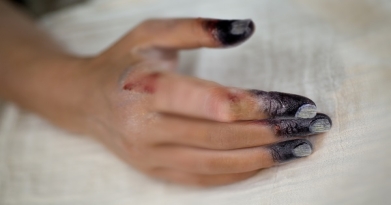
Athletes participating in outdoor winter sports, such as alpine and cross-country skiing, snowboarding, and mountaineering, are at an increased risk for developing frostbite. Frostbite is a condition in which prolonged exposure to cold temperatures cause an injury resulting in tissue damage— starting superficially with the skin and potentially spreading deeper to blood vessels, muscles, tendons, and even bone.
What Does Frostbite Feel Like?
Many people who are developing frostbite experience early symptoms such as numbness or a tingling sensation in the skin, such as the “pins and needles” that you can feel after a hand or foot falls asleep. The affected body part may also be extremely painful, feel itchy, or have a burning sensation. The skin can initially appear white or grey with a surrounding area of redness, and as frostbite progresses, blisters may form and the skin will feel hard, waxy, or numb.
Who is at Risk?
While anyone can potentially develop frostbite, both the very young and the elderly are at particularly high risk and should take special precautions to prevent over-exposure in cold environments. In addition, athletes with medical conditions such as diabetes or heart conditions can be at increased risk due to decreased blood flow to the skin.
How Cold is Too Cold?
Generally, the risk of frostbite is low when the outside temperature is above 14°F (-10°C), but that risk can go up significantly with prolonged exposure, increased elevation (>17,000 feet), and increased wind speed.
How Do You Treat Frostbite?
Preventing injury begins with protection from the elements, which requires getting out of the cold as soon as possible and replacing all wet clothing with dry, warm, insulated layers. Immobilizing the extremity to prevent damage to the cold, stiff skin and muscles can prevent further injury. Once inside, rewarming the affected extremity should be done rapidly by immersion in a warm water bath at 104°–107.6°F (40°–42°C) for 15 to 30 minutes until thawing is complete.1,2 If warm water is not available, body heat can be used to rewarm the hands or feet, such as tucking them in your armpits. When successful, the skin becomes soft and pinkish again. Avoid rubbing or massaging the skin to avoid damaging the skin or rupturing blisters.
An Ounce of Prevention
While outdoor winter sports provide an excellent opportunity for physical exercise and competition, they can be dangerous if athletes are not properly prepared. Useful tips to help prevent frostbite include:
- Check weather forecasts to prepare for inclement weather or avoid extreme weather.
- Wear adequate clothing to protect from the cold and wind—dressing in loose-fitting layers, including fabric that wicks away body moisture and sweat is best.
- Cover exposed skin with gloves or mittens, a hat, scarf, and face mask, if needed.
- Minimize alcohol consumption and tobacco use.
- Stay active! Physical activity maintains core body temperature as well as increases blood flow to the hands and feet.









